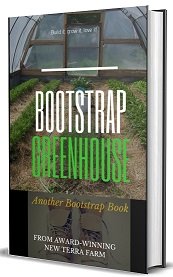Some Tips On Extending the Garden Season (without breaking the bank!)
Getting ready for the 2020 season, I want to talk about getting more from your garden next season. Even in a cold climate extending the garden season beyond what most people think is possible is very feasible. And you can do this without breaking the bank.
It's mostly a matter of some smart choices, supplemented with a little appropriate technology. FYI I'm in Canadian hardiness zone 5, roughly equivalent to U.S. Hardiness zone 4; here's how we eat from our garden 12 months of the year.
First let me clarify there's the garden growing season and then there's the eating-from-the-garden season. Let's talk about extending the growing season first. These techniques have passed the test of practicality; there's no point in spending more than the value of the produce itself to stretch out the growing a bit.
Extending the garden season begins with careful site selection. This is the easiest and cheapest way to get more sooner from your garden. My garden sites have been chosen for their 'micro-climates'. I have a 'sunny garden' and a 'shady garden'.
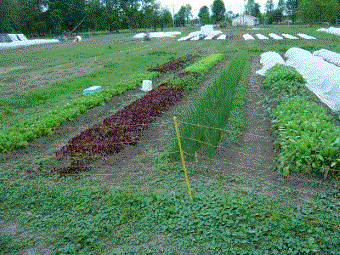 The sunny garden at New Terra Farm
The sunny garden at New Terra FarmThe sunny garden, with a slight slope to the south-east, gets the most sun and warms up first in the spring. I plant the earliest crops here, and also the heat-lovers like tomatoes, peppers, and eggplant.
The only drawback to this site is the lack of windbreak from the north. My winds are predominately from the south-west, but the occasional north wind can be very hard on crops. So I protect the earliest crops with row cover (see more about that below.)
The shady garden has trees to the south and east; its a good spot for mid-summer lettuces and greens that don't appreciate the full summer sun. This garden also slopes slightly to the south-east. Always be aware of the slope of your garden because cold air and frost can 'pool' in low-lying areas.
Extending the garden season with careful crop selection. This might seem obvious, but to harvest crops early, you have to pick a cultivar that will 1 – germinate in cool soil, and 2 – has a shorter 'days to maturity'. Your seed catalog usually has this information.
Here's an example; I grow a bush bean called 'Provider'; it's a dark-seeded bush bean. Dark-seeded bush beans germinate better in cool soil than light-seeded cultivars.
I can plant Provider a couple weeks earlier than other beans I grow. Provider also has a fairly short days to maturity, making it a great bean for the early market. I can also plant it here in mid-summer and get a crop in about 6 weeks. This makes it a good fall bean, too.
Which brings me to extending the garden season by staggering planting dates. We plant many cultivars every two weeks throughout the season. We get in the outdoor garden in mid-April most years. We keep planting some crops right up until mid-September. This takes a bit of planning to make sure your choice of crops will have time to mature; spreadsheets are great tools for this.
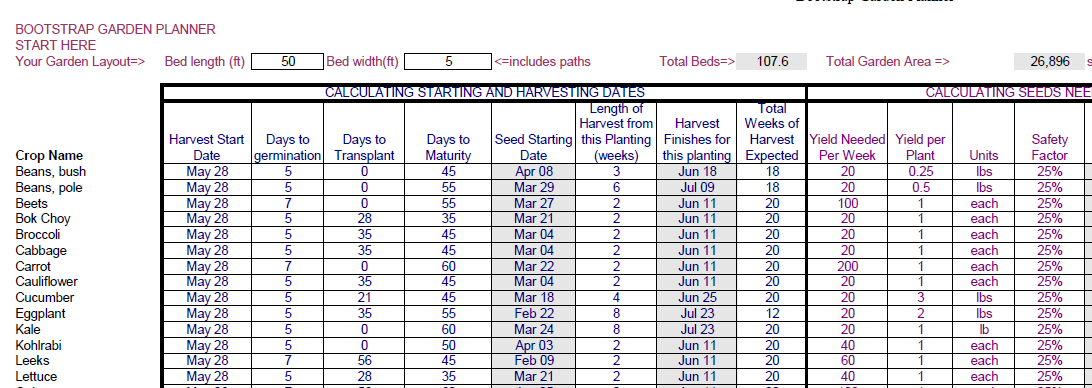 Screenshot from my Garden Planner spreadsheet. You can get this with my Bootstrap Market Gardening pack
Screenshot from my Garden Planner spreadsheet. You can get this with my Bootstrap Market Gardening packExtending the garden season - more . . .
Extending the garden season with transplants. If you grow where I do, transplants are absolutely necessary to have a reasonable growing season. The first year we operated our CSA, we started all our transplants on two home-made light stands in our living room!
We built the light stands from 2 x 2 lumber and used cheap florescent shop lights to grow the plants. We put the lights on timers, 14 hours on and 10 off. Each stand, which cost us about $150 including the light, could hold 16 trays of seedlings.
We had 16 families in our CSA that year. Some of the money from that first garden paid for my plant starting room and my first little lean-to greenhouse. This greatly extended the number of transplants we could grow. But anybody could start with two plant stands like ours, for very little money.
Extending the garden season with the gardener's “secret weapon” – row cover. I love row cover; you can probably tell that from the photo above. It is probably the single most useful 'tool' for the small organic grower. Row cover lets me start planting in my outdoor garden a full month before last frost.
Row cover lets me put plants out without having to harden them off. This is gardening heresy, I know, but I have never lost a spring plant to cold under row cover.
And row cover provides the windbreak that is missing from my sunny garden. I believe early crops are more damaged by wind than cold. And, row cover is a physical barrier against insect pests as well; I couldn't grow brassicas without it.
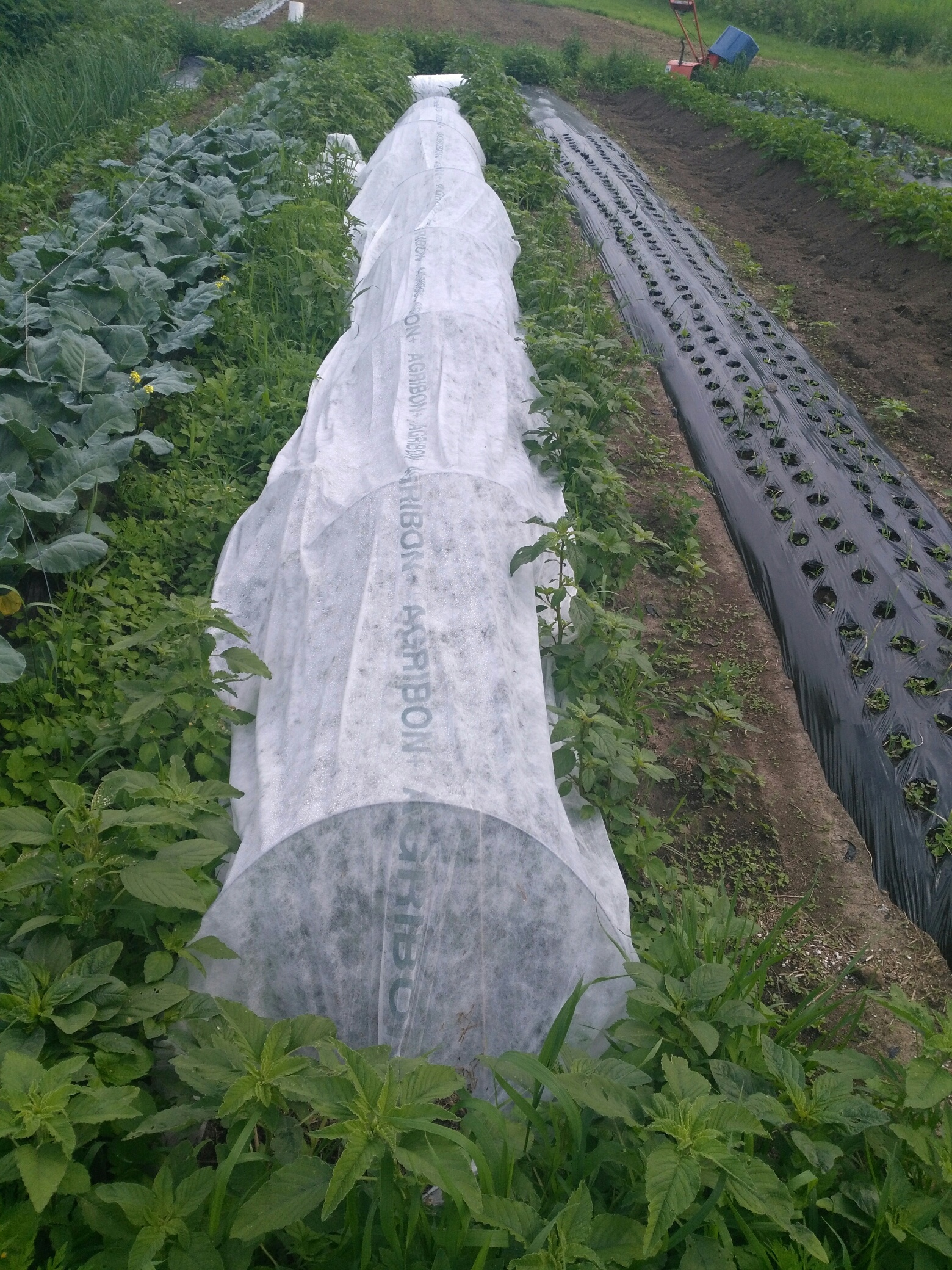 Plastic film and row cover let me grow sweet potatoes in the Great White North
Plastic film and row cover let me grow sweet potatoes in the Great White NorthExtending the garden season with film mulch. I use a plastic
sheet film mulch in my garden to warm up the soil for the earliest crops
and to keep down weeds. Plastic mulch paired with row cover can produce
crops weeks earlier than the unprotected garden.
Placing drip hose under the mulch film makes watering easy. The
only problem with the mulch is picking it up when the season is over.
However with careful planning the plastic mulch can remain place for 2
seasons; just pull out the residue plant stalks in the fall, and plant a
different crop in the spring. Note that the plastic mulch film can be
recycled, although not all facilities accept it.
Extending the garden season with a poly tunnel. My unheated high
tunnel poly hoophouse is a source of great satisfaction for me. Last
season I started working in there at the end of February! There was
still snow on the ground outside when I planted the first crops at the
beginning of March. And the hoophouse also helped me produce many
thousands of transplants, as well as bedding plants for sale.
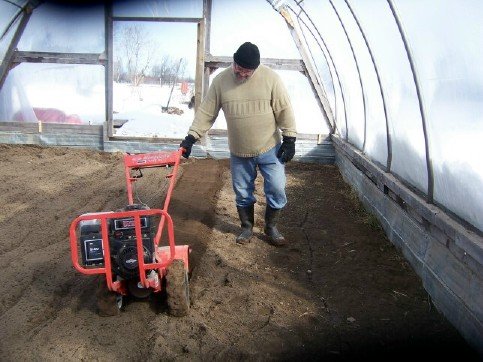 Happily at work in February in my hoophouse
Happily at work in February in my hoophouseExtending the garden season in a hoophouse works at the other end of the calendar, too. If you build a movable hoophouse like mine, you can greatly extend your fall harvest as well. I believe it will be ultimately possible for me to harvest from my hoophouse for 9 or 10 months of the year.
Eliot Coleman of Four Season Farm has been an inspiration to me on this topic. My greenhouse on rails is modeled on his design.
Extending the EATING season
As I mentioned, the growing season and the eating season don't necessarily coincide. When the growing is done, I still have storage vegetables in my cool room – rutabaga, potatoes, carrots, garlic, onions – as well as some pickled and frozen selections. These things will last me until new crops come in the spring.
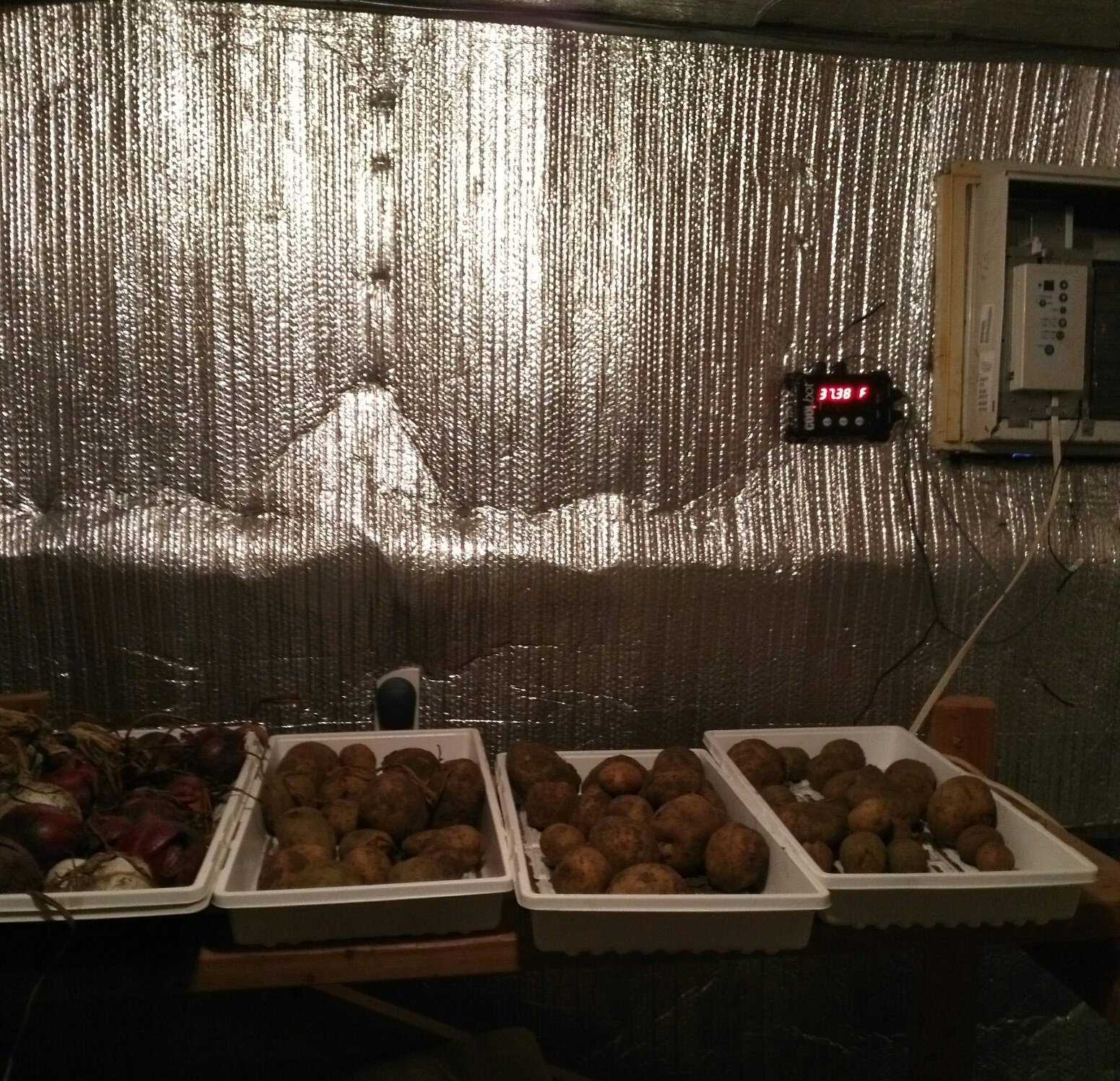 My cold room is insulated to r40 and sealed with foil-backed bubble wrap
My cold room is insulated to r40 and sealed with foil-backed bubble wrap
By the way, my cool room used to be my old plant-starting room. This was
a 10-foot by 12-foot heavily-insulated 'box within a box' I built in
one of my outbuildings, and fitted up with plant stands and grow lights.
Then a couple years ago, when I built a bigger and better plant starting
room; the old room became my walk-in cooler for summer harvests, and my
cold storage room in the winter. A room air conditioner cools the room
in the summer, and a baseboard electrical heater keeps it from freezing
in the winter. It was another great investment that I use 12 months a
year.
So, am I growing a complete year-round diet? No, but as I learn
more about extending the garden season I am getting closer to that goal.
The point is I can meet at least part of my food needs from my garden 12 months a year.
I also have a couple freezers (outside, of course) full of my own organic free-range chicken and pork. And all this was accomplished without a huge investment upfront; we really did 'bootstrap' our way to where we are now.
I hope this gives you some ideas and inspiration for your garden next season. Have a great 2020, grow some great food, and find a little joy in your garden.
A fellow grower lost out on $5,000 in her first season because of one simple mistake. Get your FREE Market Garden Starter Guide and avoid this costly error.
Imagine building a profitable and sustainable market garden even on a small property.
Enter your email address and your free report will be sent to you right away.
Our latest Bootstrap Book will show you step-by-step how to build a greenhouse and use it to best advantage your small farm.
We include plans and directions to
build each of the 3 greenhouse designs we use on New Terra Farm.
Check out Bootstrap Greenhouse here.
Or get Bootstrap Greenhouse as part of my Complete Start Farming Pack and save even more.
- Home Page ›
- High income Market Garden ›
- Extending the Garden Season
- Home Page ›
- Build a Greenhouse ›
- Extending the Garden Season
Recent Articles
-
Farm grown reviews of products recommended by New Terra Farm
Dec 04, 25 06:26 AM
Find great farm and garden products in my farm grown reviews -
Best Chicken Coop and Accessories for Small Farms and Homesteads
Nov 30, 25 09:18 AM
Looking for the best chicken coop? Here are the top coops, accessories, nest boxes, and gear to build a safe, productive poultry setup. -
Community Supported Agriculture Marketing Ideas To Sell Out The Season
Nov 05, 25 05:18 AM
Authentic Community Supported Agriculture marketing ideas to grow loyalty, boost sign-ups, and sell out your CSA every year





